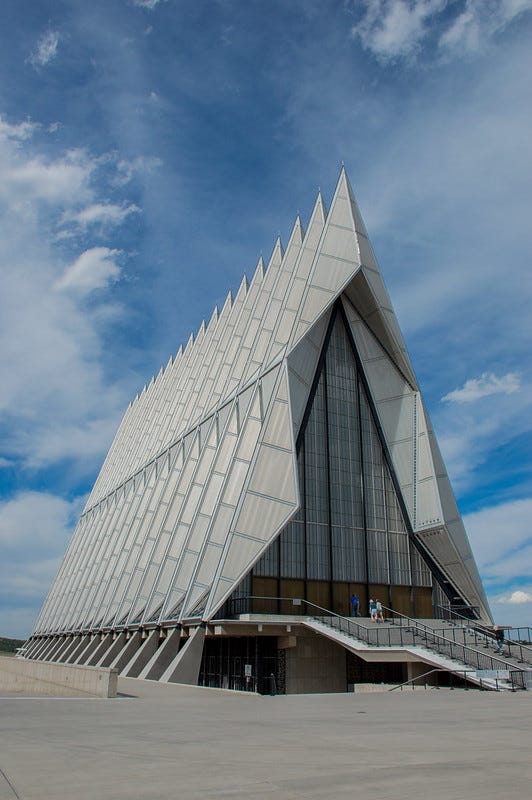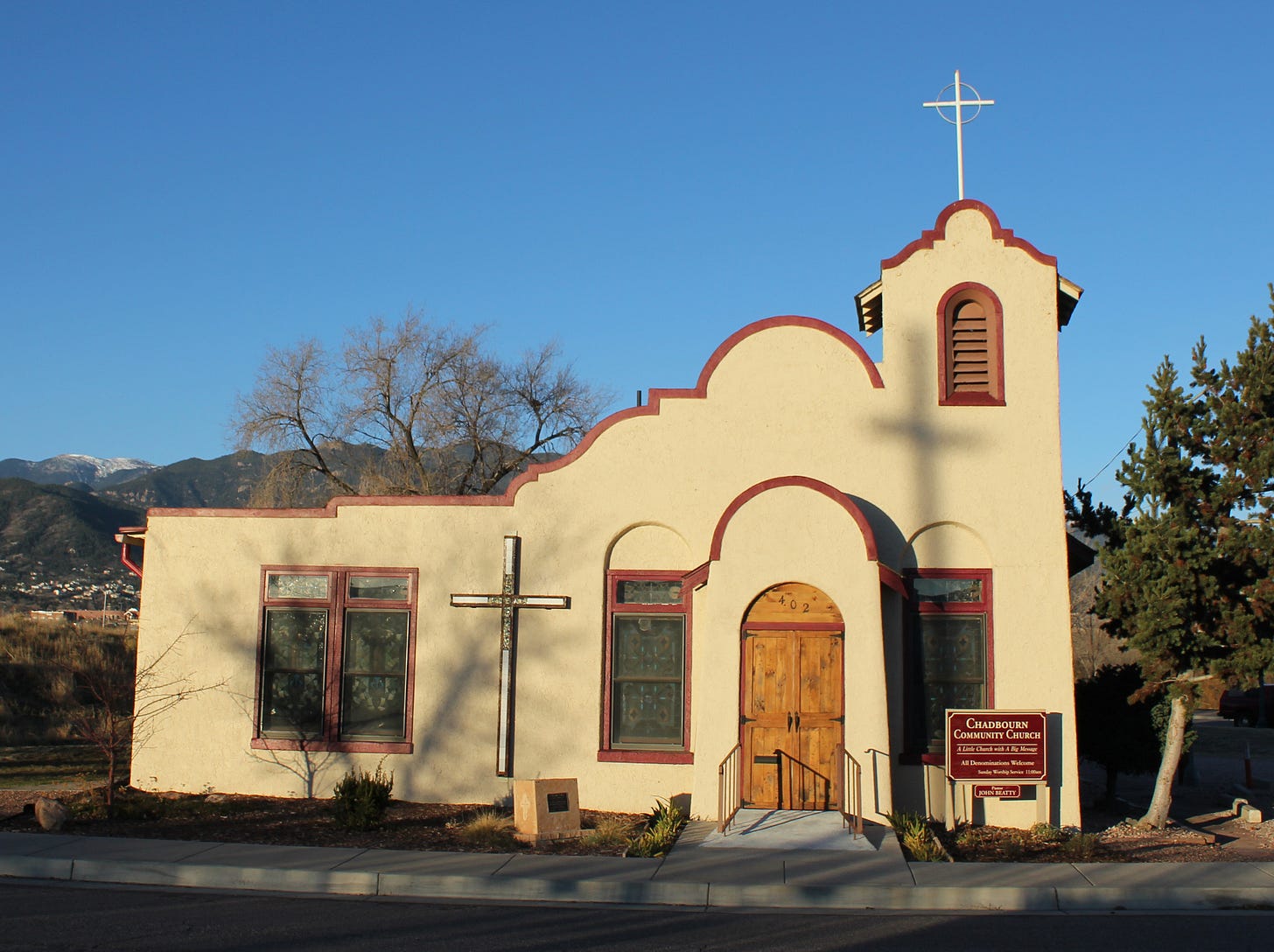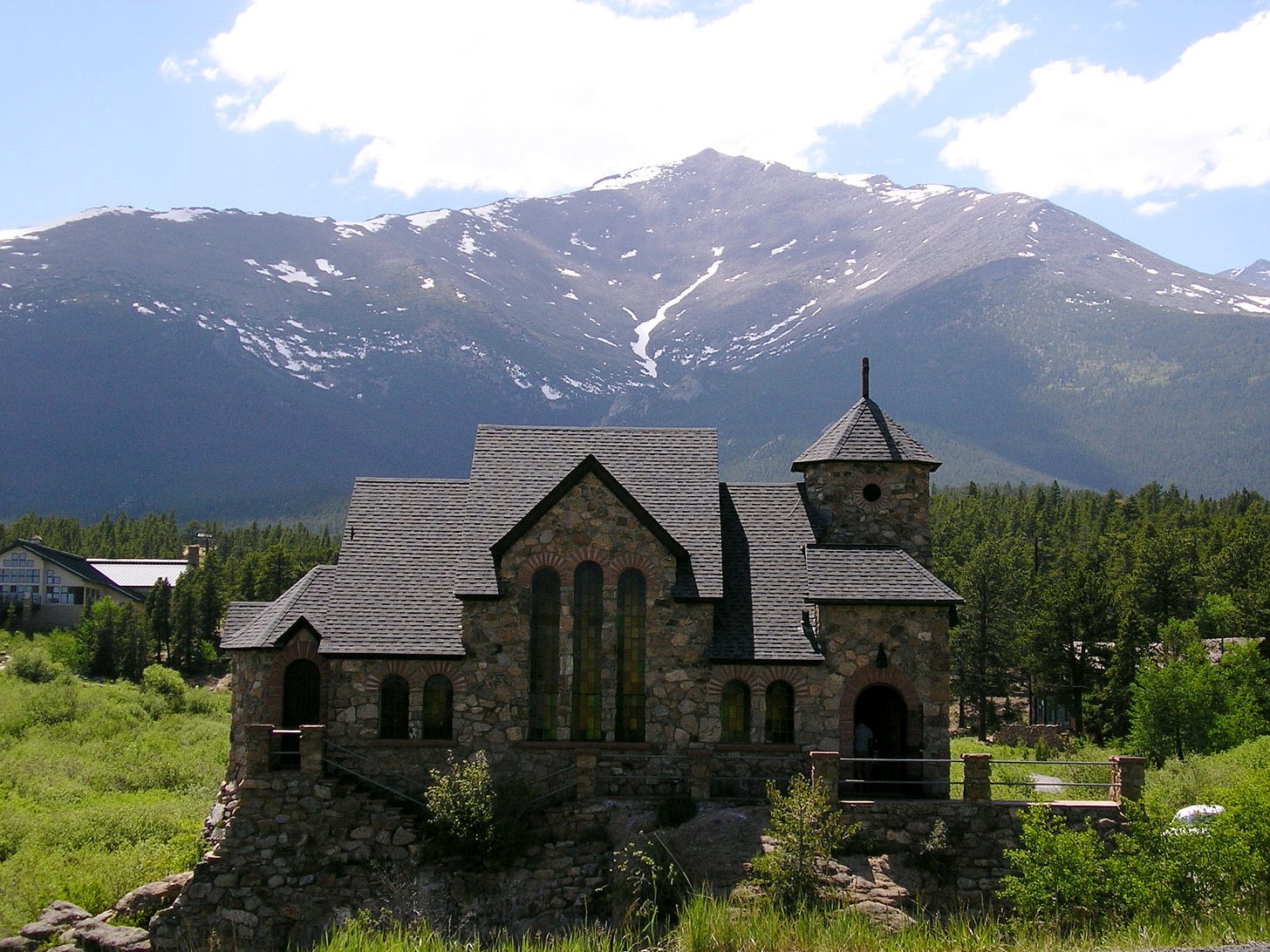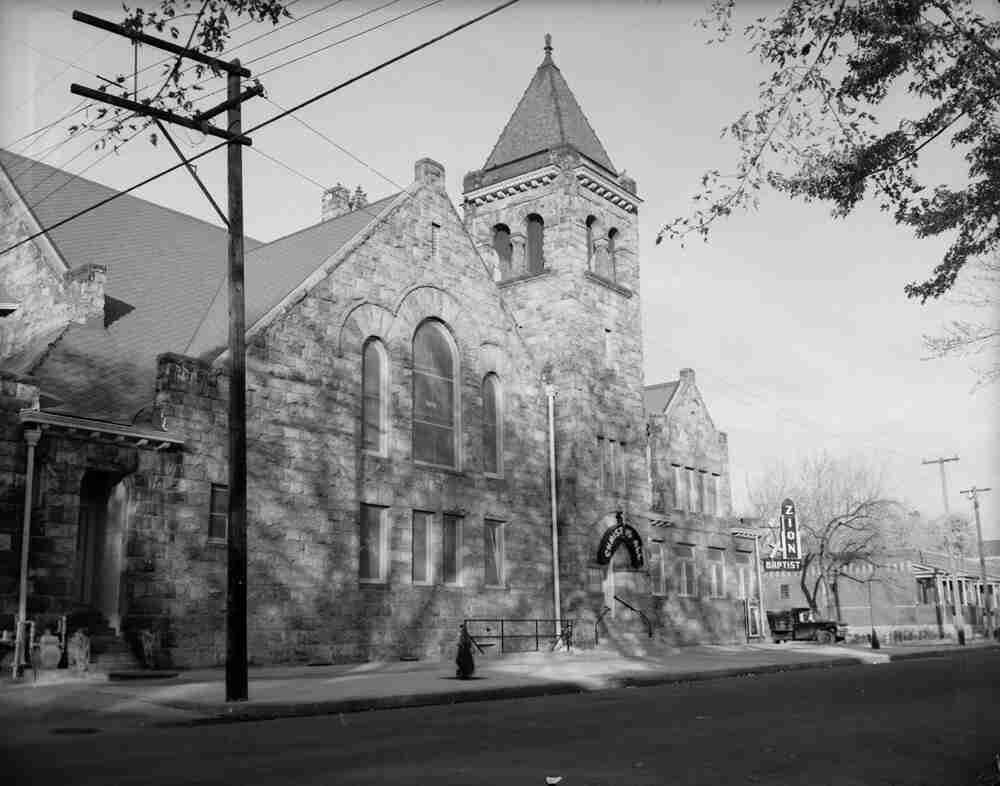Holy Places
Herein, a list of places in Colorado of religious and historical significance to Jews and Christians, worthy of visit or pilgrimage, in alphabetical order, and kept updated.
Page construction in progress | Last updated 3.5.24
Abbey of St. Walburga
✟ Christian (Roman Catholic) | Virginia Dale, CO
Home to a community of Benedictine sisters in a verdant valley in northern Colorado, the Abbey of St. Walburga is named in honor of St. Walburga, an eighth-century Anglo-Saxon missionary to what is now Germany. The motherhouse, St. Walburga’s Abbey, is in Eichstätt, Bavaria. The Colorado community was established in 1935 when the Abbess, concerned about the rise of Hitler and the Nazi party, set up several American missions (including St. Walburga Monastery, in Covington, Kentucky and St. Emma Monastery in Greenburg, Pennsylvania). Today, the sisters live in community, raise llamas, farm the land, and welcome pilgrims and guests. As contemplative Benedictine nuns, their primary duty is to pray the full Divine Office, a series of seven prayer services held throughout the day. Prayer services and daily Mass are open to the public. The abbey is also open to guests for day and overnight retreats.
Abbey of St. Walburga | Northern Colorado History
Cadet Chapel
✡ Jewish, ✟ Christian, and Other | Colorado Springs, CO

The Cadet Chapel at the U.S. Air Force Academy is an all-faith house of worship for cadets and staff, with separate chapels for Protestant, Catholic, Jewish, and Buddhist faiths, and two all-faith worship rooms. The 150-foot structure is made of aluminum, glass, and steel chapel; consists of 100 identical tetrahedrons, each weighing five tons; and features 17 spires, a number the Air Force insists has “no significance.” The furnishings and pipe organs were gifts from individuals and organizations. An Easter offering taken at Air Force bases around the world in 1959 funded completion of the interior. The foyer surrounding the interior Jewish synagogue is paved with 1,631 pieces of Jerusalem stone donated by the Israeli Defense Forces. The Chapel hosts up to a million visitors per year.
Cathedral Basilica of the Immaculate Conception
✟ Christian (Roman Catholic) | Denver, CO

Construction of this Cathedral, in the French Gothic style, began in 1906 and was completed six years later. It was elevated to a lesser basilica—an honorific bestowed by the Pope to designate a church of special historical or spiritual importance—in 1979. The foundation is granite from Gunnison, Colorado; the exterior walls are Indiana limestone; and much of the interior is marble from Marble, Colorado. The altars, pedestals, statues, pulpit, bishop’s throne (kathedra), and communion rail are of marble imported from Carrara, Italy. The 75 stained glass windows, crafted by F.X. Zettler and 50 artisans in Munich, Germany, are considered some of the finest in the world. The Cathedral Basilica hosts three daily Masses and five Sunday Masses, ministers to the local faithful, and serves the surrounding community. It also hosts a regular concert series.
Cathedral Website | Catholic Places
Chadbourne Spanish Gospel Mission
✟ Christian (Nondenominational Protestant) | Colorado Springs, CO

Located in the historic Conejos District, a working-class community of Jewish, Scandinavian, and Hispanic immigrants, the original building on this site was built around 1910 as a simple one-story grocery store. Under the leadership of missionary Ruth Chadbourne, it was renamed the Spanish Gospel Mission in 1930 and later renovated in the Mission Revival style. (A bell donated by Colorado College was installed in the bell tower in the late 1940s.) As a nondenominational church, the Mission offered services in Spanish and English, Sunday school, and Bible studies; provided adult education classes in English, sewing, and music; hosted sports teams and Boy and Girl Scouts meetings; provided food to needy children and gifts at Christmas; and hosted various community events. According to its application for the National Register of Historic Places (a designation it achieved in 2009), the Mission was “the only community gathering place in the area” and “became the nucleus of the neighborhood.” The Mission is the sole surviving structure from the Conejos District. Today it is home to the Chadbourne Community Church.
History Colorado | Colorado Springs Pioneer Museum
Mother Cabrini Shrine
✟ Christian (Roman Catholic) | Golden, CO

Situated in the foothills west of Denver, Mother Cabrini Shrine was originally a summer camp for girls. When St. Frances Xavier (“Mother”) Cabrini, founder of the Missionary Sisters of the Sacred Heart of Jesus, purchased the property in 1909, there was no known source of water. Water had to be hauled up to the summer camp from a stream at the bottom of Mt. Vernon Canyon. When the sisters complained to Mother Cabrini that they were dying of thirst—and Colorado summers are quite warm and dry!—Mother Cabrini answered, “Lift that rock over there and start to dig. You will find water fresh enough to drink and clean enough to wash.” They did, and discovered a spring. Today, the spring is housed in an 8000-gallon tank and has never stopped running. The Shrine includes a museum dedicated to the life and missionary work of Mother Cabrini, as well as a stairway of prayer, meditation walk, rosary garden, retreat facilities, and daily Mass. The Shrine is open every day for visitors and pilgrims.
Mother Cabrini Shrine | Catholic Places
Mount of the Holy Cross
✟ Christian | Holy Cross Wilderness Area (Eagle County), CO

Between Vail to the north and Leadville to the south, in the Sawatch Range, rises this unusual 14,005-foot mountain featuring a 1500-foot couloir (vertical cleft) intersected by a 750-foot horizontal bench, forming a Christian cross that keeps snow well into July. Because of its remote location, Mount of the Holy Cross was known largely in rumor and seen by very few until the celebrated western photographer William Henry Jackson took the first-ever photo of it. It became an American sensation. Jackson’s photo inspired a famous painting by Thomas Moran (now in the Autry Museum of the American West in Los Angeles) and a poem by Henry Wadsworth Longfellow in memory of the tragic death of his wife. Pilgrims flocked to see the cross by climbing a ridge on nearby Notch Mountain, where a stone hut was constructed in the 1920s to shelter hikers and host Sunday masses. According to a Summit Daily article, this was also the birthplace of “handkerchief healing.” At the urging of a Denver pastor, sick people around the country began mailing in handkerchiefs, and the pastor carried them up Notch Mountain, prayed over them, and mailed them back to their owners. In 1932, he schlepped 2000 handkerchiefs, enlisting two rangers to help carry the load. Between 1929 and 1950, there was a Holy Cross National Monument, but after a rock slide that marred the cross’s right arm, visitation declined, and the area was stripped of the designation and returned to the Forest Service. Today, Mount of the Holy Cross is the centerpiece of the Holy Cross Wilderness Area, created in 1980. Hikers summit the mountain to “bag” one of the state’s many fourteeners, or they climb a ridge on Notch Mountain for the iconic view and shelter. Pilgrims still journey here for inspiration, solitude, and prayer.
National Parks Traveler | 5280 | EARTH Magazine
Shrine of the Stations of the Cross
✟ Christian (Roman Catholic) | San Luis, CO

Officially La Mesa de la Piedad y de la Misericordia, or Hill of Piety and Mercy, the Shrine is part of the Sangre de Cristo Parish. A half-mile trail allows visitors to view the fifteen Stations of the Cross—bronze sculptures of Christ’s passion and resurrection, sculpted by Huberto Maestas in 1986. Beyond the stations is a grotto of Our Lady of Guadalupe with sandstone statues of the Virgin Mary and Juan Diego. Atop the mesa is La Capilla de Todos Los Santos, the Chapel of All Saints, a mission-style church.
Catholic Places | Southern Colorado Guide | Sangre de Cristo Heritage Center
St. Catherine of Siena Chapel (Chapel on the Rock)
✟ Christian (Roman Catholic) | Allenspark, CO
Near the southern entrance to Rocky Mountain National Park, set against the backdrop of Mt. Meeker, St. Catherine of Siena Chapel is a literal embodiment of what it means to “build upon the rock.” Set upon a foundation of natural rock—a survivor of the glacial forces that shaped this area—the Chapel was built in 1935 using native stone sourced nearby. It’s named in honor of the fourteenth-century Italian mystic known for her intense fasting and prayer. The surrounding property is called Camp St. Malo—after a sixth-century Welsh saint, with a nod to the donors (Mr. and Mrs. Oscar Malo) who gave the land to the Archdiocese. In 2011, a tragic fire destroyed a conference center on the property. In 2013, 100-year rains triggered flooding and landslides, bringing mud and rocks from the slopes of Mt. Meeker to the base of the chapel, destroying the Pope Saint John Paul II trail in the process. But the Chapel on the Rock stood firm. A rebuilt trail now features the Stations of the Cross, showcasing the artwork of Canadian sculptor Timothy Schmalz. The Chapel is open Tuesday to Sunday, 10 am to 4 pm, and welcomes visitors seeking to pray or enjoy the serene beauty of this place. On site, Tahosa Coffee House serves drip coffee, espresso drinks, and small bites. In December, there’s an Advent Market, with local artisans and vendors, homemade foods, mulled wine, and a warm fire.
Camp St. Malo | Inspired Imperfection
Temple Aaron
✡ Jewish | Trinidad, CO

Temple Aaron is the second oldest continually operating Jewish synagogue west of the Mississippi. The town of Trinidad was incorporated in 1876 (the same year Colorado became a state), and its first mayor, Sam Jaffa, was Jewish. The local Jewish community formed Congregation Aaron in 1883 and, six years later, laid the cornerstone for this synagogue, a red-brick and stone structure overlooking the town center. According to a 2019 article in HaLapid, the unusual Eastern-Islamic design “was brought to America by German Jews who had been impacted by the Reform Movement in Judaism.” Colorado Public Radio calls it “exotic-revival style.” (Denver’s Temple Emanuel boasts a similar design.) In 2023, Temple Aaron was added to the list of National Historical Landmarks.
Temple Aaron | Jewish Museum of the American West
Temple Israel
✡ Jewish (Reform) | Leadville, CO

Originally constructed in 1884 and restored in 2008, Temple Israel served a large and active community of pioneering Reform Jews until about 1914. Today it houses a museum run by the Temple Israel Foundation, documenting Jewish life in a late-1800s mining town. The building was designed by George King in a style called Carpenter Gothic, complementing St. George’s Episcopal Church across the street. An interpretive sign outside the building calls it a “frontier synagogue,” and online commentary suggests an architectural significance to this term (though I’ve not been able to discover its source or meaning). At an elevation of about 10,000 feet, Temple Israel may be the highest Jewish house of worship in the world.
Temple Israel Foundation | Jewish Museum of the American West
Zion Baptist Church
✟ Christian | Denver, CO
Founded by an intrepid group of Black freedmen on November 15, 1865, Zion Baptist Church is the oldest African American church in the Rocky Mountain West, and is today a Colorado historical landmark. From small beginnings, the congregation grew to become a pillar of the Black community in Denver and included many of the city’s Black business owners and political leaders. It was a “mother church,” helping to found other Black congregations throughout the Rocky Mountain West. Since 1913, the church has occupied a large brick building in Denver’s Five Points neighborhood, built in the Romanesque Revival style. It has hosted many civil rights leaders over the years, including A. Philip Randolph, Rev. Dr. Martin Luther King Jr., and Jesse Jackson. It celebrated its 150th anniversary in 2015. From its historic location, it continues today to minister to the faithful and serve the community through a variety of ministries and programs.


